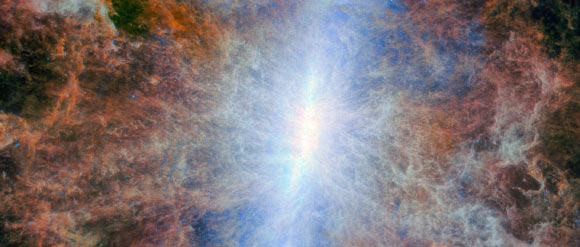Using the Mid-InfraRed Instrument (MIRI) aboard the NASA/ESA/CSA James Webb Space Telescope, astronomers have captured a stunning infrared image of central part of Messier 82, an edge-on starburst galaxy located about 12 million light-years away.
This Webb/MIRI image shows the central part of the starburst galaxy Messier 82. Image credit: NASA / ESA / CSA / Webb / A. Bolatto.
Messier 82 appears high in the northern spring sky in the direction of the constellation of Ursa Major.
First discovered by the German astronomer Johann Elert Bode in 1774, this galaxy is approximately 40,000 light-years across.
Messier 82 is also called the Cigar Galaxy because of the elongated elliptical shape produced by the tilt of its starry disk relative to our line of sight.
The galaxy is famous for its extraordinary speed in making new stars, with stars being born 10 times faster than in our Milky Way Galaxy.
“Despite being smaller than the Milky Way, Messier 82 is five times as luminous as our home Galaxy and forms stars ten times faster,” Webb astronomers said in a statement.
“Messier 82 is classified as a starburst galaxy because it is forming new stars at a rate much faster than expected for a galaxy of its size, especially at its center.”
In visible-light images of Messier 82, the central hotbed of activity is obscured by a network of thick and dusty clouds, but Webb’s infrared eyes are designed to peer through this cloudy veil and reveal the activity behind them.
“What caused Messier 82’s burst of star formation? The answer likely lies with its neighbor, the larger spiral galaxy Messier 81,” the astronomers said.
“We suspect that the two galaxies have interacted gravitationally, sending gas pouring into Messier 82’s center millions of years ago.”
“The influx of gas provided the raw material for new stars to form — and form they did! Messier 82 is home to more than 100 super star clusters, some of which are still in the process of forming and are blanketed with dense, dusty gas.”
“Super star clusters are more massive and luminous than typical star clusters; these ones each contain around 100,000 stars.”
A previous Webb image of Messier 82, featuring data from the telescope’s Near-InfraRed Camera (NIRCam), was released in 2024.
It focused on the very core of the galaxy, where individual clusters of young stars stand out against the clumps and tendrils of gas.
The new image, captured by Webb’s MIRI instrument, provides a remarkable, mostly starless view of Messier 82.
“The image is instead dominated by the emission from warm dust and intricate clouds of sooty organic molecules called polycyclic aromatic hydrocarbons or PAHs,” the researchers said.
“The emission from the PAH molecules traces the galaxy’s broad outflows, which are launched by the intense radiation and winds from the hot young stars of the central super star clusters.”
“Though super star clusters are the source of Messier 82’s powerful galactic winds, the winds may spell the end for the galaxy’s starburst era: as the winds billow into intergalactic space, they likely carry with them the cool gas needed to form even more stars.”
